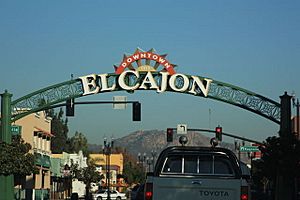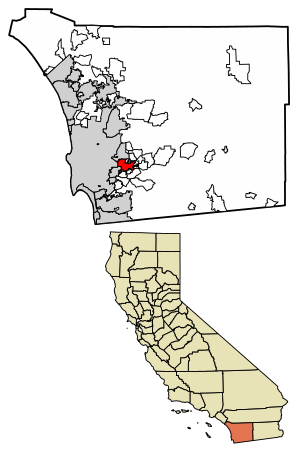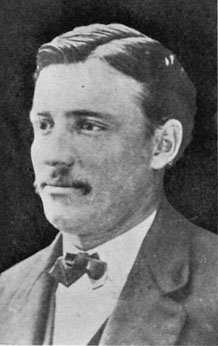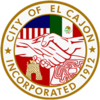El Cajon, California facts for kids
Quick facts for kids
El Cajon, California
El Cajón
|
|||
|---|---|---|---|
 |
|||
|
|||
| Motto(s):
"The Valley of Opportunity"
|
|||

Location of El Cajon in San Diego County, California
|
|||
| Country | |||
| State | |||
| County | |||
| Incorporated | November 12, 1912 | ||
| Area | |||
| • Total | 14.51 sq mi (37.58 km2) | ||
| • Land | 14.51 sq mi (37.58 km2) | ||
| • Water | 0.00 sq mi (0.00 km2) 0% | ||
| Elevation | 433 ft (132 m) | ||
| Population
(2020)
|
|||
| • Total | 106,215 | ||
| • Rank | 68th in California 319th in the United States |
||
| • Density | 7,320.1/sq mi (2,826.4/km2) | ||
| Time zone | UTC−8 (Pacific) | ||
| • Summer (DST) | UTC−7 (PDT) | ||
| ZIP Codes |
92019–92022, 92090
|
||
| Area code | 619 | ||
| FIPS code | 06-21712 | ||
| GNIS feature IDs | 1652701, 2410406 | ||
El Cajon is a city in San Diego County, California. It's about 17 miles (27 km) east of downtown San Diego. The city's name comes from a Spanish word, El Cajón, which means "the box." This name was chosen because the valley around the city looks like a box. That's why people sometimes call El Cajon "the Box."
Contents
What's in a Name?

The name El Cajón (meaning "the box" in Spanish) was first used on September 10, 1821. It described how the valley was "boxed-in." The name appeared on maps as "Cajon" in 1873 and 1875. When the modern town grew, its post office was named "El Cajon."
In 1905, a California historian named Zoeth Skinner Eldredge insisted that the name be changed back to "El Cajon."
A Look Back: El Cajon's History
Early Days and Ranchos
During Spanish rule (1769–1821), the government created large land areas called ranchos. These were given to the Roman Catholic Church, which built many missions. In the early 1800s, mission leaders looked for good places for their cattle. They found the El Cajon Valley. The hills around it kept cattle from wandering off. They also helped collect the little rainfall. For many years, the El Cajon Valley was used for the mission's cattle.
Individual people didn't get land until the Mexican era (1821–1846). In 1834, a law was passed to divide church land among Native American people. But most of the land was given to wealthy "Californios" (people of Spanish background). In 1845, California Governor Pio Pico took land from Mission San Diego de Alcala. He gave about 48,800 acres of the El Cajon Valley to Dona Maria Antonio Estudillo. This was to pay back a $500 government debt.
This land was first called Rancho Santa Monica. It included what is now El Cajon, Bostonia, Santee, Lakeside, Flinn Springs, and part of La Mesa. Dona Maria Estudillo was married to Don Miguel Pedrorena. He was from Spain and came to California in 1838.
Becoming Part of the United States
After the Mexican–American War in 1848, California became part of the United States. The Treaty of Guadalupe Hidalgo said that the land grants would still be valid. In 1852, a claim for Rancho El Cajon was made for Pedrorena's children. It was approved by the U.S. Supreme Court in 1876.
In 1868, a land developer from Los Angeles, Isaac Lankershim, bought most of the Rancho El Cajon land. He hired Major Levi Chase to manage it. Chase received 7,624 acres, known as the Chase Ranch. Lankershim then hired Amaziah Lord Knox to manage Rancho El Cajon. In 1876, Knox opened a hotel there. This hotel served people traveling between San Diego and Julian, where gold had been found in 1869. A room and food for a guest and horse cost $1 a night.
The area became known as Knox's Corners. Later, it was renamed. By 1878, 25 families lived in the valley. A part of the hotel became the valley's post office, with Knox as the first postmaster.
Modern El Cajon
El Cajon officially became a city in 1912. For the first half of the 1900s, El Cajon was known for growing grapes, avocados, and citrus fruits.
In the 1960s and 1970s, there was a fun tourist spot called Frontier Town, Big Oak Ranch. It was a theme park that looked like an old frontier town. It even had pretend shootouts! The park closed around 1980. Now, homes are built there.
Cajon Speedway was a 70-acre race track. It was open from 1961 to 2005. It was known as "The fastest 3/8-mile paved oval in the West." Even though it closed, it's now a historic museum. You can see the original entrance sign there.
Where is El Cajon?
El Cajon covers about 14.4 square miles (37.3 square kilometers) of land. It is next to San Diego and La Mesa to the west. To the south is Spring Valley. To the north is Santee. Unincorporated parts of San Diego County are to the east. Some neighborhoods in El Cajon include Fletcher Hills, Bostonia, and Rancho San Diego.
El Cajon's Weather
El Cajon has a mix of a Mediterranean climate and a semiarid climate. This means it has mild, wet winters and hot, dry summers. The weather can change a lot over short distances. This is called a microclimate. El Cajon's weather is more extreme than coastal San Diego. The farther east you go from the coast, the drier it gets.
Temperatures usually change moderately between day and night. The average difference is about 24°F (13°C) in summer and 26°F (14°C) in winter.
El Cajon gets about 11.63 inches (295 mm) of rain each year. Most of the rain falls in winter, and it's rare in summer. February is usually the wettest month.
The highest temperature ever recorded was 114°F (46°C) on September 5, 2020. The lowest was 19°F (-7°C) on January 8, 1913. It rarely snows, but 0.3 inches (0.8 cm) fell in November 1992. In January 1882, 3 inches (8 cm) of snow covered the ground!
| Climate data for El Cajon, California (1991–2020 normals, extremes 1979–present) | |||||||||||||
|---|---|---|---|---|---|---|---|---|---|---|---|---|---|
| Month | Jan | Feb | Mar | Apr | May | Jun | Jul | Aug | Sep | Oct | Nov | Dec | Year |
| Record high °F (°C) | 93 (34) |
95 (35) |
98 (37) |
104 (40) |
104 (40) |
107 (42) |
113 (45) |
107 (42) |
114 (46) |
106 (41) |
99 (37) |
93 (34) |
114 (46) |
| Mean maximum °F (°C) | 83.8 (28.8) |
84.3 (29.1) |
86.8 (30.4) |
91.1 (32.8) |
92.0 (33.3) |
94.0 (34.4) |
98.7 (37.1) |
100.4 (38.0) |
102.5 (39.2) |
97.7 (36.5) |
90.9 (32.7) |
82.0 (27.8) |
104.8 (40.4) |
| Mean daily maximum °F (°C) | 69.3 (20.7) |
69.2 (20.7) |
71.3 (21.8) |
74.5 (23.6) |
76.2 (24.6) |
80.8 (27.1) |
86.1 (30.1) |
88.6 (31.4) |
87.3 (30.7) |
81.0 (27.2) |
75.2 (24.0) |
68.5 (20.3) |
77.3 (25.2) |
| Daily mean °F (°C) | 55.9 (13.3) |
56.8 (13.8) |
59.7 (15.4) |
62.6 (17.0) |
66.1 (18.9) |
70.1 (21.2) |
74.7 (23.7) |
76.6 (24.8) |
74.7 (23.7) |
68.3 (20.2) |
61.2 (16.2) |
55.1 (12.8) |
65.1 (18.4) |
| Mean daily minimum °F (°C) | 42.5 (5.8) |
44.4 (6.9) |
48.0 (8.9) |
50.7 (10.4) |
55.9 (13.3) |
59.4 (15.2) |
63.3 (17.4) |
64.7 (18.2) |
62.1 (16.7) |
55.6 (13.1) |
47.1 (8.4) |
41.7 (5.4) |
53.0 (11.7) |
| Mean minimum °F (°C) | 33.1 (0.6) |
36.0 (2.2) |
39.3 (4.1) |
43.0 (6.1) |
48.8 (9.3) |
53.4 (11.9) |
57.5 (14.2) |
58.8 (14.9) |
54.2 (12.3) |
45.5 (7.5) |
37.2 (2.9) |
32.3 (0.2) |
31.2 (−0.4) |
| Record low °F (°C) | 26 (−3) |
28 (−2) |
30 (−1) |
36 (2) |
43 (6) |
46 (8) |
50 (10) |
50 (10) |
49 (9) |
35 (2) |
29 (−2) |
25 (−4) |
25 (−4) |
| Average precipitation inches (mm) | 2.32 (59) |
2.61 (66) |
1.92 (49) |
0.75 (19) |
0.30 (7.6) |
0.06 (1.5) |
0.16 (4.1) |
0.02 (0.51) |
0.11 (2.8) |
0.54 (14) |
1.01 (26) |
1.83 (46) |
11.63 (295) |
| Average precipitation days (≥ 0.01 in) | 5.6 | 7.0 | 5.1 | 3.5 | 2.2 | 0.6 | 0.6 | 0.4 | 0.6 | 1.7 | 3.4 | 5.5 | 36.2 |
| Source: NOAA | |||||||||||||
People of El Cajon
| Historical population | |||
|---|---|---|---|
| Census | Pop. | %± | |
| 1920 | 469 | — | |
| 1930 | 1,050 | 123.9% | |
| 1940 | 1,471 | 40.1% | |
| 1950 | 5,600 | 280.7% | |
| 1960 | 37,618 | 571.8% | |
| 1970 | 52,273 | 39.0% | |
| 1980 | 73,892 | 41.4% | |
| 1990 | 88,693 | 20.0% | |
| 2000 | 94,869 | 7.0% | |
| 2010 | 99,478 | 4.9% | |
| 2020 | 106,215 | 6.8% | |
| U.S. Decennial Census | |||
In 2020, El Cajon had a population of 106,215 people. The city is known for its diverse population. Many people from different backgrounds call El Cajon home.
Diverse Community
El Cajon has a large population of immigrants, especially from Iraq. These include both Arab and Chaldean Catholics (a Christian group). Both of these groups have some of the largest communities in the United States right here in El Cajon. In 2017, it was estimated that between 15,000 and 20,000 Chaldean-Assyrians lived in the city.
El Cajon's Economy
The Parkway Plaza shopping mall is a major shopping spot in El Cajon.
Top Employers in El Cajon
Many people work for different organizations and companies in El Cajon. Here are some of the top employers:
| # | Employer | # of Employees |
|---|---|---|
| 1 | Cajon Valley Union School District | 1,412 |
| 2 | GKN Aerospace Chem-tronics | 859 |
| 3 | Grossmont–Cuyamaca Community College District | 712 |
| 4 | City of El Cajon | 450 |
| 5 | Grossmont Union High School District | 431 |
| 6 | Taylor Guitars | 400 |
| 7 | Country Hills Health Care & Rehabilitation Center | 357 |
| 8 | University Mechanical and Engineering Contractors | 352 |
| 9 | The Home Depot | 339 |
| 10 | Walmart | 260 |
Schools and Colleges
El Cajon has many schools for students of all ages. The Cajon Valley Union School District runs the public elementary and middle schools. The Grossmont Union High School District runs the public high schools.
Public Elementary Schools
- Anza Elementary
- Avocado Elementary
- Blossom Valley Elementary
- Bostonia Elementary
- Chase Avenue Elementary
- Crest Elementary
- Dehesa School
- Fletcher Hills Elementary
- Flying Hills Elementary
- Fuerte Elementary
- Jamacha Elementary
- Johnson Elementary
- Lexington Elementary
- Madison Elementary
- Magnolia Elementary
- Meridian Elementary
- Naranca Elementary
- Rancho San Diego Elementary
- Rios Elementary
- Vista Grande Elementary
- W.D. Hall Elementary
Public Middle Schools
- Cajon Valley Middle School
- Greenfield Middle School
- Hillsdale Middle School
- Los Coches Creek Middle School
- Montgomery Middle School
Public High Schools
- Chaparral High School
- Christian High School
- El Cajon Valley High School
- Granite Hills High School
- Grossmont High School
- Grossmont Middle College High School
- IDEA Center High School
- Valhalla High School
- Steele Canyon High School
Private Schools
- Foothills Christian Schools (Preschool, middle school, and high school campuses)
Colleges in El Cajon
- Advanced Training
- Cuyamaca College
- Grossmont College
- San Diego Christian College
- Seminary of Mar Abba the Great of the Chaldean Catholic Church
Fun Things to Do and See
Yearly Events
Every May, El Cajon celebrates its many cultures with "America on Main Street." This free event is great for families. It shows off the city's identity as a "mini-United Nations." About 30% of its people are immigrants from countries like Iraq, Somalia, Syria, and Turkey.
El Cajon also has its annual Mother Goose Parade. It has been held every year since 1946 on the Sunday before Thanksgiving. Organizers say it's the biggest parade in San Diego County! It features over 100 entries, including floats, marching bands, clowns, and giant helium balloons. Even Santa Claus makes an appearance!
Places to Visit
Some fun places to visit in and around El Cajon include:
- The Water Conservation Garden and Butterfly Garden at Cuyamaca College
- Sycuan Casino
- Summers Past Farms
- The Parkway Plaza Mall
Airports
- Gillespie Field is an airport located in El Cajon.
Famous People from El Cajon
Many notable people have lived in El Cajon, including:
- Lester Bangs, a famous rock music critic
- Kurt Bevacqua, former Major League Baseball player
- Aaron Boone, former Major League Baseball player
- Bob Boone, former Major League Baseball player
- Bret Boone, former Major League Baseball player
- Tony Clark, former Major League Baseball player
- Kevin Correia, former Major League Baseball player
- Dave Dravecky, former Major League Baseball player
- Amy Finley, host of a TV show called The Gourmet Next Door
- Brian Giles, former Major League Baseball player
- Marcus Giles, former Major League Baseball player
- Broc Glover, a professional motocross racer
- A.J. Griffin, current Major League Baseball player
- Ryan Hansen, an actor
- Jimmie Johnson, a seven-time NASCAR champion
- Ricky Johnson, a motocross racer
- Joe Kennedy, former Major League Baseball player
- David Lee, an Olympic gold medalist in volleyball
- Greg Louganis, an Olympic diver who won gold medals in 1984 and 1988
- Mark Malone, former NFL football player and sportscaster
- Joe Musgrove, current Major League Baseball player
- Swen Nater, former NBA basketball player
- Brian Sipe, former NFL football player
- Shane Spencer, former Major League Baseball player
- Kyle Stowers, Current Major League Baseball player
- Tommy Vardell, former NFL football player
- James Wong, a television producer
- Frank Zappa, a famous musician
- Barry Zito, former Major League Baseball player
Images for kids
See also
 In Spanish: El Cajón (California) para niños
In Spanish: El Cajón (California) para niños








